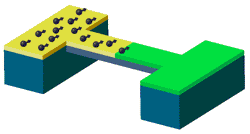Tiny Twister

Trucks drive over the Golden Gate Bridge with little effect, but a proposed nanoscale bridge would shudder even from the flow of electrons. The device, described theoretically in the 2 September PRL, would detect the electrons’ spins by measuring the bridge’s tilt as the electrons traverse it. Running it backward by forcing the bridge to tilt could generate a current of electrons with aligned spins. The device could be an essential component in the emerging field of spintronics–electronics that manipulate electron spins in addition to charges–which may someday transform information technology and computing.
Ordinarily, the electrons in a material have randomly aligned spins. Spintronics devices would align the spins and move electrons around as “spin currents.” It has proven difficult, however, to detect small spin currents and to shrink the measuring devices to the size that engineers want for sophisticated electronics and computing.
Now, building on ideas from another team [1] Anatoly Mal’shukov of the Russian Academy of Sciences in Moscow and his colleagues propose a nanoscale spin current measuring device: a suspended, bridge-like beam that twists when a spin current flows through it. The beam they describe is a few hundred nanometers wide and thick, a couple of microns long, and is built from a chunk of insulating material with a layer of semiconductor on top.
As electrons whiz through a semiconductor crystal, they feel a small electric field from the material’s atoms. Since the electrons are moving, the electric field appears to them as partially transformed into a magnetic field. Electrons try to align their spins with a magnetic field, but if they are already aligned, they have another preference: stronger fields are better than weaker ones. That’s why two distant bar magnets pull toward one another–the close-up field is the strongest and provides the lowest energy for the system. A similar energy lowering causes the nanobeam to twist.
In a perfect crystal, the net electromagnetic field is zero, but if the crystal is distorted a bit–as with a thin beam that always has some random thermal jiggling–the net field can be significant. A spin current would cause the beam to further increase the field by twisting, because a larger field would lower the energy associated with the spin-aligned electrons, Mal’shukov and his colleagues show theoretically. The more spin current that goes in, the farther the beam twists, making it a good spin current meter.
The researchers imagine that if the spin current isn’t constant in time, but comes in bursts, it could give the beam periodic kicks that synchronize with the natural periodic motion of the beam twisting one direction and then the other. They calculate that with a 10 nanoamp spin current, the beam would twist by about one ten-thousandth of a degree in angle–big enough to detect with today’s technology. In theory, the process is reversible: Apply a periodic twist to the beam, and a related effect should send spin-up and spin-down electrons in opposite directions, creating a spin current.
The paper is “very important,” says Pritiraj Mohanty of Boston University. “People talk a lot about spintronics in semiconductors, but people haven’t succeeded in showing you can actually detect spins in a clean way,” he says. Once such a device is built, Mohanty says, a host of new spintronics components may become feasible.
–Mason Inman
Mason Inman is a freelance science writer in San Francisco.
References
- P. Mohanty et al., “Spin-Mechanical Device for Detection and Control of Spin Current by Nanomechanical Torque,” Phys. Rev. B 70, 195301 (2004)


